Andrew Vanderburg
A Machine-Learning Compositional Study of Exoplanetary Material Accreted Onto Five Helium-Atmosphere White Dwarfs with $\texttt{cecilia}$
May 09, 2025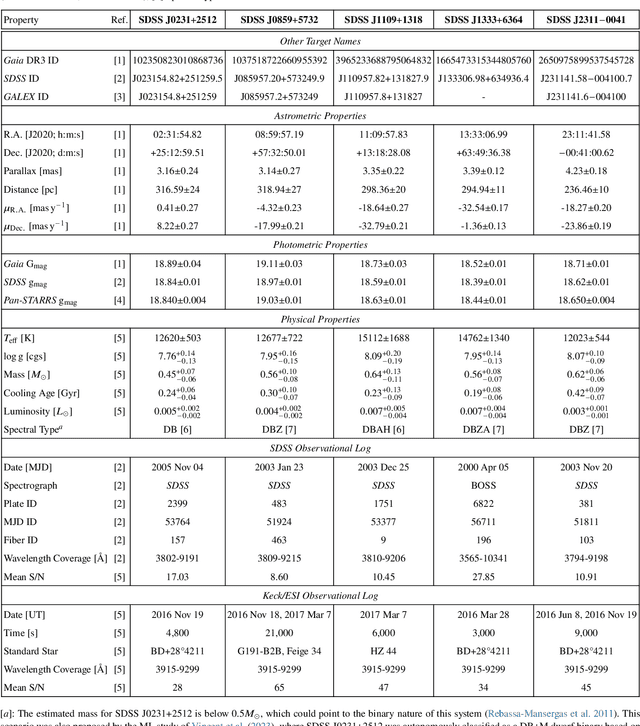
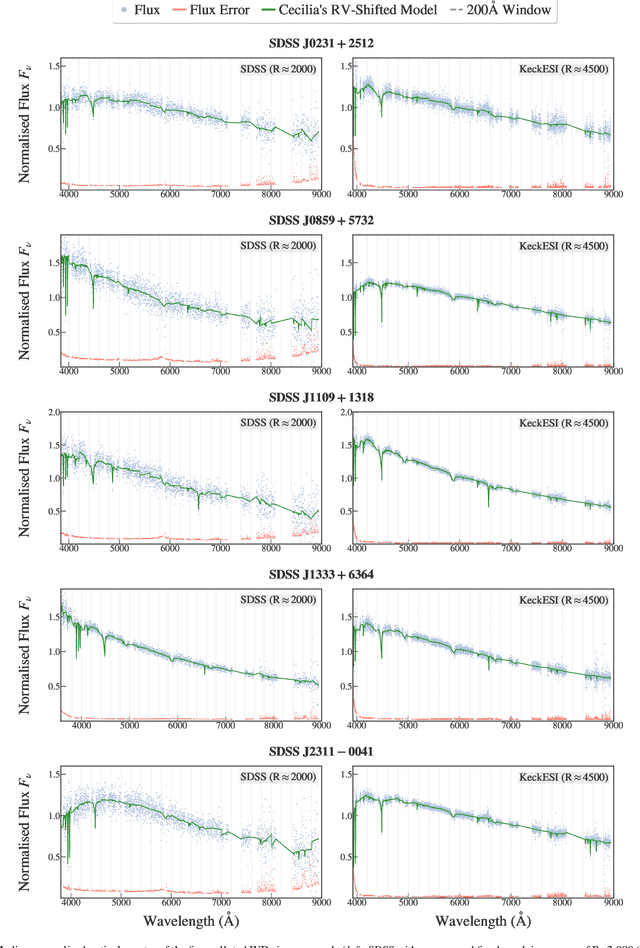
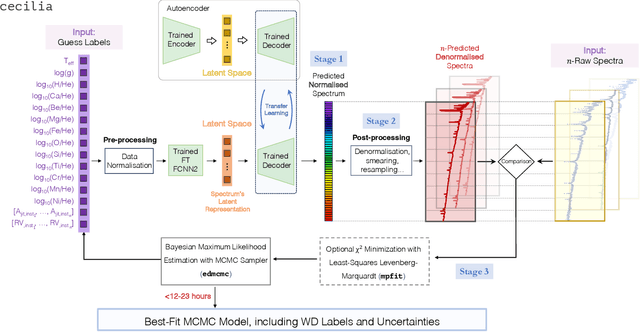
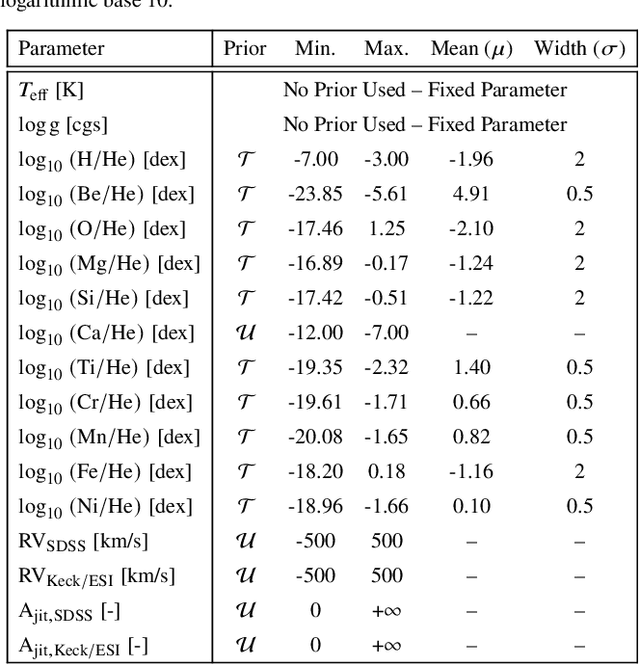
Abstract:We present the first application of the Machine Learning (ML) pipeline $\texttt{cecilia}$ to determine the physical parameters and photospheric composition of five metal-polluted He-atmosphere white dwarfs without well-characterised elemental abundances. To achieve this, we perform a joint and iterative Bayesian fit to their $\textit{SDSS}$ (R=2,000) and $\textit{Keck/ESI}$ (R=4,500) optical spectra, covering the wavelength range from about 3,800\r{A} to 9,000\r{A}. Our analysis measures the abundances of at least two $-$and up to six$-$ chemical elements in their atmospheres with a predictive accuracy similar to that of conventional WD analysis techniques ($\approx$0.20 dex). The white dwarfs with the largest number of detected heavy elements are SDSS J0859$+$5732 and SDSS J2311$-$0041, which simultaneously exhibit O, Mg, Si, Ca, and Fe in their $\textit{Keck/ESI}$ spectra. For all systems, we find that the bulk composition of their pollutants is largely consistent with those of primitive CI chondrites to within 1-2$\sigma$. We also find evidence of statistically significant ($>2\sigma$) oxygen excesses for SDSS J0859$+$5732 and SDSS J2311$-$0041, which could point to the accretion of oxygen-rich exoplanetary material. In the future, as wide-field astronomical surveys deliver millions of public WD spectra to the scientific community, $\texttt{cecilia}$ aspires to unlock population-wide studies of polluted WDs, therefore helping to improve our statistical knowledge of extrasolar compositions.
LensNet: Enhancing Real-time Microlensing Event Discovery with Recurrent Neural Networks in the Korea Microlensing Telescope Network
Jan 10, 2025Abstract:Traditional microlensing event vetting methods require highly trained human experts, and the process is both complex and time-consuming. This reliance on manual inspection often leads to inefficiencies and constrains the ability to scale for widespread exoplanet detection, ultimately hindering discovery rates. To address the limits of traditional microlensing event vetting, we have developed LensNet, a machine learning pipeline specifically designed to distinguish legitimate microlensing events from false positives caused by instrumental artifacts, such as pixel bleed trails and diffraction spikes. Our system operates in conjunction with a preliminary algorithm that detects increasing trends in flux. These flagged instances are then passed to LensNet for further classification, allowing for timely alerts and follow-up observations. Tailored for the multi-observatory setup of the Korea Microlensing Telescope Network (KMTNet) and trained on a rich dataset of manually classified events, LensNet is optimized for early detection and warning of microlensing occurrences, enabling astronomers to organize follow-up observations promptly. The internal model of the pipeline employs a multi-branch Recurrent Neural Network (RNN) architecture that evaluates time-series flux data with contextual information, including sky background, the full width at half maximum of the target star, flux errors, PSF quality flags, and air mass for each observation. We demonstrate a classification accuracy above 87.5%, and anticipate further improvements as we expand our training set and continue to refine the algorithm.
Identifying Exoplanets with Deep Learning. V. Improved Light Curve Classification for TESS Full Frame Image Observations
Jan 03, 2023Abstract:The TESS mission produces a large amount of time series data, only a small fraction of which contain detectable exoplanetary transit signals. Deep learning techniques such as neural networks have proved effective at differentiating promising astrophysical eclipsing candidates from other phenomena such as stellar variability and systematic instrumental effects in an efficient, unbiased and sustainable manner. This paper presents a high quality dataset containing light curves from the Primary Mission and 1st Extended Mission full frame images and periodic signals detected via Box Least Squares (Kov\'acs et al. 2002; Hartman 2012). The dataset was curated using a thorough manual review process then used to train a neural network called Astronet-Triage-v2. On our test set, for transiting/eclipsing events we achieve a 99.6% recall (true positives over all data with positive labels) at a precision of 75.7% (true positives over all predicted positives). Since 90% of our training data is from the Primary Mission, we also test our ability to generalize on held-out 1st Extended Mission data. Here, we find an area under the precision-recall curve of 0.965, a 4% improvement over Astronet-Triage (Yu et al. 2019). On the TESS Object of Interest (TOI) Catalog through April 2022, a shortlist of planets and planet candidates, Astronet-Triage-v2 is able to recover 3577 out of 4140 TOIs, while Astronet-Triage only recovers 3349 targets at an equal level of precision. In other words, upgrading to Astronet-Triage-v2 helps save at least 200 planet candidates from being lost. The new model is currently used for planet candidate triage in the Quick-Look Pipeline (Huang et al. 2020a,b; Kunimoto et al. 2021).
Identifying Exoplanets with Deep Learning. IV. Removing Stellar Activity Signals from Radial Velocity Measurements Using Neural Networks
Nov 04, 2020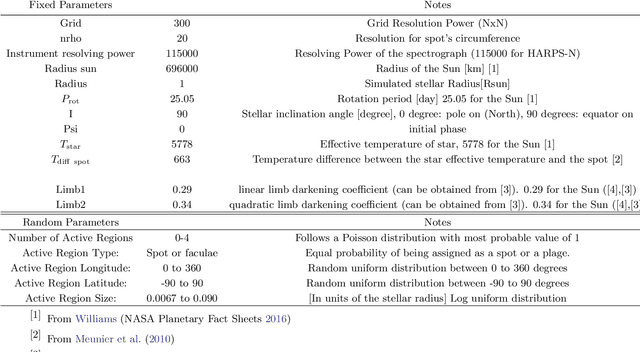
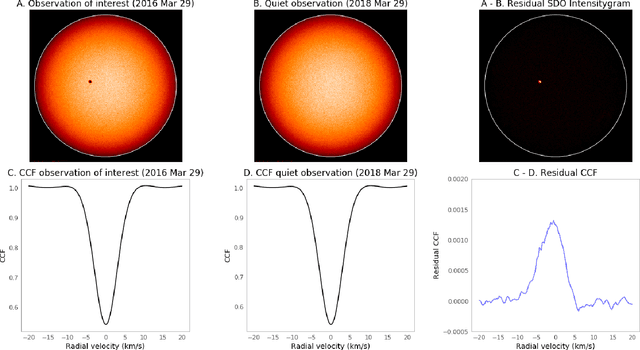
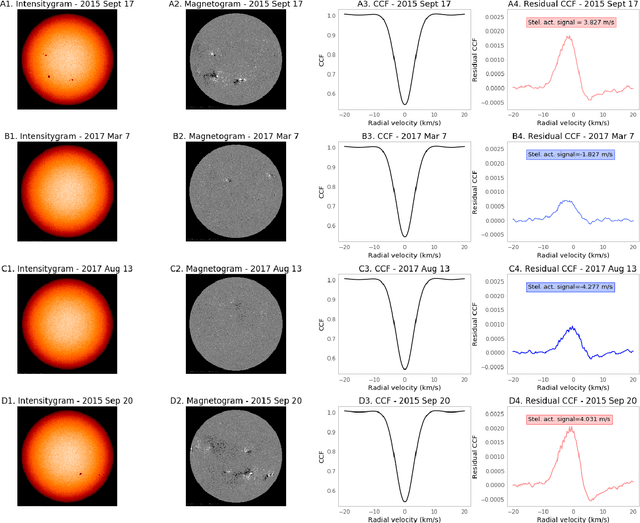

Abstract:Exoplanet detection with precise radial velocity (RV) observations is currently limited by spurious RV signals introduced by stellar activity. We show that machine learning techniques such as linear regression and neural networks can effectively remove the activity signals (due to starspots/faculae) from RV observations. Previous efforts focused on carefully filtering out activity signals in time using modeling techniques like Gaussian Process regression (e.g. Haywood et al. 2014). Instead, we systematically remove activity signals using only changes to the average shape of spectral lines, and no information about when the observations were collected. We trained our machine learning models on both simulated data (generated with the SOAP 2.0 software; Dumusque et al. 2014) and observations of the Sun from the HARPS-N Solar Telescope (Dumusque et al. 2015; Phillips et al. 2016; Collier Cameron et al. 2019). We find that these techniques can predict and remove stellar activity from both simulated data (improving RV scatter from 82 cm/s to 3 cm/s) and from more than 600 real observations taken nearly daily over three years with the HARPS-N Solar Telescope (improving the RV scatter from 1.47 m/s to 0.78 m/s, a factor of ~ 1.9 improvement). In the future, these or similar techniques could remove activity signals from observations of stars outside our solar system and eventually help detect habitable-zone Earth-mass exoplanets around Sun-like stars.
 Add to Chrome
Add to Chrome Add to Firefox
Add to Firefox Add to Edge
Add to Edge